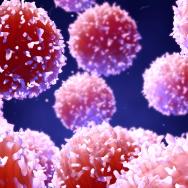A group of University of Chicago scientists has uncovered a previously unknown way that our genes are made into reality.
Rather than directions going one-way from DNA to RNA to proteins, the latest study shows that RNA itself modulates how DNA is transcribed—using a chemical process that is increasingly apparent to be vital to biology. The discovery has significant implications for our understanding of human disease and drug design.
“It appears to be a fundamental pathway we didn’t know about. Anytime that happens, it holds promise to open up completely new directions of research and inquiry,” said Prof. Chuan He, a world-renowned chemist.
The human body is among the most complex pieces of machinery to exist. Every time you so much as scratch your nose, you’re using more intricate engineering than any rocket ship or supercomputer ever designed. It’s taken us centuries to deconstruct how this works, and each time someone discovers a new mechanism, a few more mysteries of human health make sense—and new treatments become available.
For example, in 2011, He opened a new avenue of research with his discovery of a particular process called reversible RNA methylation, which plays a critical role in how genes are expressed.
The picture many of us remember learning in school is an orderly progression: DNA is transcribed into RNA, which then makes proteins that carry out the actual work of living cells. But it turns out there are a lot of wrinkles.

He’s team found that the molecules called messenger RNA, previously known as simple couriers that carry instructions from DNA to proteins, were actually making their own impacts on protein production. This is done by a reversible chemical reaction called methylation; He’s key breakthrough was showing that this methylation was reversible. It wasn’t a one-time, one-way transaction; it could be erased and reversed.
“That discovery launched us into a modern era of RNA modification research, which has really exploded in the last few years,” said He. “This is how so much of gene expression is critically affected. It impacts a wide range of biological processes—learning and memory, circadian rhythms, even something so fundamental as how a cell differentiates itself into, say, a blood cell versus a neuron.”
He’s team also identified and characterized a number of “reader” proteins that recognize methylated mRNA and impact target mRNA stability and translation.
But as He’s lab worked with mice to understand the mechanisms, they began to see that messenger RNA methylation could not fully explain everything they observed.
This was mirrored in other experiments. “The data coming out of the community was saying there’s something else out there, something extremely important that we’re missing—that critically impacts many early development events, as well as human diseases such as cancer,” He said.
“This has major implications in basic biology.”
He’s team discovered that a group of RNAs called chromosome-associated regulatory RNAs, or carRNAs, was using the same methylation process, but these RNAs do not code proteins and are not directly involved in protein translation. Instead, they controlled how DNA itself was stored and transcribed.
“This has major implications in basic biology,” He said. “It directly affects gene transcriptions, and not just a few of them. It could induce global chromatin change and affects transcription of 6,000 genes in the cell line we studied.”
He sees major implications in biology, especially in human health—everything from identifying the genetic basis of disease to better treating patients.
“There are several biotech companies actively developing small molecule inhibitors of RNA methylation, but right now, even if we successfully develop therapies, we don’t have a full mechanical picture for what’s going on,” he said. “This provides an enormous opportunity to help guide disease indication for testing inhibitors and suggest new opportunities for pharmaceuticals.”
Their breakthrough is only the beginning, He said. “I believe this represents a conceptual change,” he said. “Barriers like these are hard to crack, but once you do, everything flows from there.”
Citation: “N6-methyladenosine of chromosome-associated regulatory RNA 1 regulates chromatin state and transcription.” Liu et al, Science, Jan. 20, 2020. DOI: 10.1126/science.aay6018
Funding: U.S. National Institutes of Health, National Key R&D Program of China, National Science Foundation, Howard Hughes Medical Institute.









